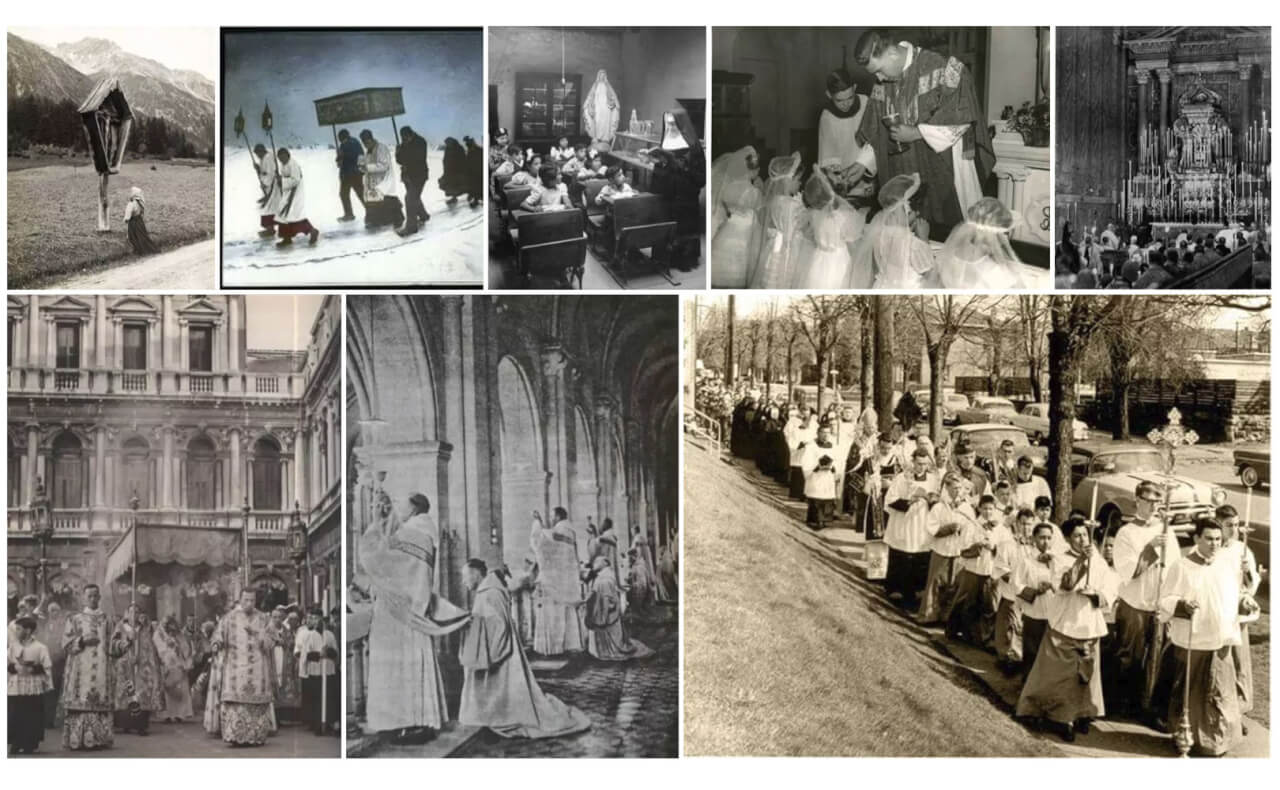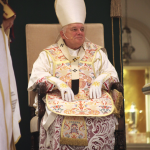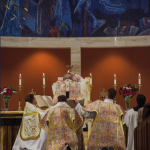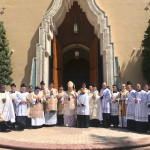When I Google “it’s not the same religion” – in quotes – the first result I get is a tweet from Hilary White about Archbishop Gómez of Los Angeles giving communion to the pro-abortion mayor.
When I Google “Novusordoism isn’t Catholicism” – in quotes – I get an entire category of posts from Hilary at her “What’s Up With Francis-Church” blog filed under that label. The most significant of these – a post entitled “To touch the sky: ‘Novusordoist’ New Paradigm isn’t the same religion” – begins with an excellent description of this phenomenon that Hilary and others (myself included) have been trying to explain for some time:
The fact that we don’t really yet have an official name for the New Paradigm (and probably won’t for another couple of centuries) has made it difficult to help clarify what I mean when I say that in effect, most regular novus ordo Mass-going Catholics don’t believe the same religious things as previous generations of Catholics believed. I’ve said it many times, and I’m not alone, that “Novusordoism isn’t Catholicism.” It’s become a bit of a catchphrase. I’ve also often used the term “New Paradigm” to refer to the creation of what is in essence, if not yet in name, the new thing created after Vatican II. I am gratified to see that the Pope’s closest collaborators are starting to promote this term themselves to describe it. Makes things easier.
How do we define it? We’ve talked about the “false floor” of the Novusordoist New Paradigm and the vast “lost city,” full of treasures, of the Catholic Faith that has been suppressed and buried since Vatican II that very very few Catholics know is down there. We’ve talked about how it’s so difficult to explain because of the great success of the NuChurchians at suppressing even the language we use (no, not Latin) to describe the concepts.
For the people who re-booted the Church in 1965, Orwell was taken as a how-to manual, not a warning. A great deal of the content of the Faith has been memory-holed, and a new edifice has been created in the gaps.
They’ve created a kind of bubble or “Matrix” – a whole false new world the very existence of which is unknown to the people living in it.
And when the old world – the one our Catholic grandparents and great grandparents would instantly recognize, in precisely the opposite way they’d feel if they walked into an average suburban parish in 2018 – makes an appearance, the guardians of the false new world seek quickly to tamp it down, to grind it out, to ensure that everyone within earshot knows “that’s not who we are anymore.”
One recent example is that of Cardinal Wilfrid Napier of South Africa, who was given a great deal of credit by “conservatives” after he pushed back on some of the machinations during the synods on the family. On Twitter, however, where he is among the more active and engaged cardinals, he has long since put to rest the notion that he is anything but a company man for the Francis Regime. Most recently, this came in the form of his critique of a traditional Mass offered by Archbishop Thomas Wenski of Miami.
“A Mass in extraordinary form,” tweeted a very pleased-looking Archbishop Wenski, “sung at St. Mary’s Cathedral on Feast of St. Michael the Archangel at conclusion of meeting of Society for Catholic Liturgy. Around 500 people attended.”
The photos Wenski included in his tweet show an event looking every bit like the Catholicism that endured for centuries, not the newfangled cheap plastic imitation most of us are used to:
Napier’s riposte to this happy event came like a tactical strike on the joyful hope evident on the faces of the young men standing with the bishop in the final photo. “Looking at this pictures [sic],” he tweeted, “reminds me of my childhood some 70 years ago. That was a time when there was a universe between the Clergy especially Bishops and Lay Faithful! Some might call it the age of supreme Clericalism. To me it’s a reminder of what we should never ever be again!”
“Supreme clericalism.” Something “we should never ever be again.” This is how a voting member of the College of Cardinals thought by many to be a “conservative” describes the beautiful ritual vestments, gestures, and liturgical actions of the Mass of the Ages – a beauty designed to give glory to God, not to elevate the men offering the sacrifice. A liturgy where God, not the “presider,” was the center of attention.
Napier is not the lone prelate in recent weeks to make an overt attack on Catholic tradition. Bishop Felix Genn of Münster – who has been accused of facilitating homosexual indoctrination of children and of not allowing his priests to preach on Catholic sexual morality from the pulpit – was reported to have said in a press conference last month, “I can tell you firmly: I do not want pre-conciliar clerical guys and I will not ordain them.”
Genn, also considered a “conservative” in some circles, will be attending this week’s Synod of Youth. Readers will perhaps remember with some irony that one of the early controversies surrounding this synod took place during its preparatory phase, in which many youth participants in the creation of a synod preparatory document felt that their voices were not heard when they asked for a focus on more reverent liturgy – specifically the traditional Mass. From my report at the time:
“I’m sure by now you’re probably aware,” read an image of one Facebook comment with all the identifying information redacted, “of the dumpster fire that is the 2018 Pre-Synodal document.” “Refreshingly, the VAST majority of responses in the group were demanding greater access to the Tridentine Mass, recapturing tradition, and greater reverence in the Mass (Whether it be EF or OF)”. Nevertheless, the commenter wrote, “many of us were shocked to find there is no mention of this in the final document” and “many young people are not happy with the current way things are going, despite what the Pre-Synodal document would have you believe.”
Why does it so often seem to be the case that the same bishops who are allowing sexual license so much latitude are the very same who find their inner disciplinarian when it comes to the Church’s traditional expressions of worship and piety? These men are not, as is demonstrated by the growing demand for the Church’s venerable liturgy, populists. They are not merely expressing the will of the faithful.
They are giving the faithful what they want them to have, and they’re giving it to them good and hard.
Another recent indication of the desperate attempt to widen the rift between the pre- and post-conciliar Church is the push from Cardinal Schönborn – archbishop of Vienna, famed editor of the Catechism of the Catholic Church, and handpicked representative of the pope’s interpretation of Amoris Laetitia – to allow the ordination of women to the diaconate. In a tweet that was published, then quickly deleted, the cardinal was quoted as saying, “I was only recently able to consecrate deacons again. A great joy. Perhaps I will one day be able to consecrate women to the diaconate…. Dear priests, have the courage for teamwork!”
Despite the disappearing act, it wasn’t long before the tweet was confirmed in a story for the Catholic News Agency (CNA). “Cardinal Christoph Schönborn,” wrote Anian Christoph Wimmer for CNA, “has said that in his view, whether the Church could ordain women as deacons remains an ‘open question.'”
The Archbishop of Vienna was speaking Sept. 29 to 1700 delegates from parish councils and other bodies in St. Stephen’s Cathedral. Reflecting that he recently had ordained 14 men to the permanent diaconate, he added, according to local news agency Kathpress, “perhaps one day also female deacons.”
Schönborn said that there had been female deacons in the Church in times past, and that “basically, this [question] is open.”
In April of this year, Schönborn had made comments indicating that an ecumenical council could change the prohibition against female ordination laid out by Pope John Paul II in Ordinatio Sacerdotalis. “The question of ordination [of women] is a question which clearly can only be clarified by a Council,” the cardinal said. “That cannot be decided upon by a pope alone. That is a question too big that it could be decided from the desk of a pope.” Asked what he meant about women’s ordination, Schönborn clarified that he was speaking of, “deaconesses, female priests, and female bishops.” In June, however, he backtracked – offering what may have been a calculated Hegelian synthesis – saying that for women, only “the diaconate, the first degree of ordination” was on the table. Admitting that “there have never been female priests in the Catholic Church” from “the beginning,” Schönborn conceded that “even Pope Francis has said that this is not foreseen in the Tradition.” But evidently, so long as we’re not making women into priests and bishops, ordaining them to the diaconate is perfectly fine.
Just. Keep. Moving. The Needle.
We hear it again and again – that the reform must press on; that what has come since the council is “irreversible.” Whether it’s the pope saying it about the liturgical “reform” or the cardinal secretary of state saying it about the Vatican II “process” of transforming the Church, this notion of irreversible forward progress away from what the Church was into the thing that they have remade it to be is driven home with such frequency that it becomes taken for granted. The Church is not immutable, resolute, and timeless; she is in a state of constant flux. “It is not possible to go backwards,” the pope admonishes us, referencing liturgical reform, “We must always go forward. Always forward! And those who go backward are mistaken…”
They want us to believe that the past is dead. That our patrimony has been gutted. That we’d better mourn it and move on, because what we have now is all we will ever have – until they change it again, and tell us we’d better like it. The progressive “theologian” Massimo Faggioli tweeted not long ago that he hoped it was not “overly optimistic to assume that Catholics should all agree on the fact that the secular state is preferable to a theocratic state.” He then noted, apparently anticipating a deluge of papal documents supporting just the opposite, “If you quote from the magisterium, try with something published after 1944.” They don’t just move the goalposts. They take them right out of the stadium.
In an essay on the liturgy for Commonweal, Faggioli again focuses on the division between the pre- and post-conciliar Church. He laments that in his motu proprio Summorum Pontificum, Pope Benedict XVI created a “fait accompli” resulting in a “new ‘bi-ritualism’” in the Roman Rite – the bringing back of an old liturgy when a new ersatz one has taken its place – which Faggioli amusingly sees as itself a violation of tradition. He also notes the role reversal of those who support the new liturgy and the old:
This new bi-ritualism is not, for the most part, an accommodation for those who grew up with the old Latin Mass; it’s aimed at a new generation of traditionalists, born after 1964, who grew up with the novus ordo. The disputes between the advocates of the liturgical reform of Vatican II and advocates of the extraordinary form are – another paradox – disputes between an older generation advocating the new and a younger generation advocating the old. These disputes have wounded the sense of communion between Catholics. The rancor of this conflict in the United States was a painful surprise for me when I first moved to this country.
They are terrified – terrified – that the revolution has very little appeal to future generations. And so they must do all they can to subvert their interest in bringing back the Church’s sacred treasures and traditions, or the doom of all they have worked for will be the real fait accompli.
One needn’t look only to the heterodox ideologues in the Church to find the tension between historical Catholicism and the present. In a discussion about a public tiff between Bishop Morlino of Madison, Wisconsin and the fiery Catholic journalist and author George Neumayr, a friend familiar with the diocesan situation in Wisconsin related that the bishop, known as one of the greatest friends of tradition in the American hierarchy, allows the old Mass, but only by priests who will also offer the Novus Ordo. There are, to my knowledge – and I’ve been asking around – no exclusive TLM chapels in Madison.
If this is true, it would be entirely unsurprising. The same is the case in the much-touted diocese of Arlington, Virginia, which has no fewer than half a dozen Sunday TLMs (and probably more) each week at various parishes. Many see that diocese as the “mecca” for traditionalist Catholics, but if you want a Mass every day of the week in the old form, you’ll have to bounce from parish to parish day by day – or else it’s the SSPX, or you leave the diocese altogether for neighboring West Virginia. This is the daily reality – and dare I say it, the schizophrenic nature – of the post-conciliar Church. Even as demand for tradition grows, even as love for tradition blossoms, our hierarchy remains inextricably chained to a mode of Catholicism that is a manifest failure. It has not retained the faithful; it has not produced vocations; it has not held off the forces of secularism; and as has become painfully clear, it has not even successfully maintained clerical celibacy and holiness. And yet, every faithful bishop and priest is forced to offer his pinch of incense to the council, to the new Mass, to the low-expectations motif of just how valid and probably not heretical it all is.
But it is wholly, woefully insufficient to sustain the faithful. That has continued, and does continue, and will continue to be made clear as the people filling the pews of every non-traditional chapel continue to diminish, or simply fill the space for other reasons while having no intention of actually honoring what the Church teaches.
But ask a priest who has had the opportunity to learn the old Mass after knowing only the new, or has immersed himself in the old theology, or has performed a couple of old-rite baptisms, and the majority of time you’ll hear, through a nervous smile, or a serious look, that the experience was transformative for him. That once he partook of the incredible richness of the Church’s extraordinary and fathomless stores, he no longer felt that they can continue to offer merely what is now considered “ordinary” – or at the very least, that doing so makes him deeply uncomfortable. Such priests recognize that the treasures that enliven their vocations, nourish their flocks, and act as a bulwark against a hostile world are right there at their fingertips, so how can they continue to treat them as though they are merely a matter of taste or preference?
As the faithful begin to arise from their slumber, awakened by scandal after scandal, and look with new, critical eyes at how we got to where we are, I suggest that they also take a hard look at all that began changing in 1965, and the birthright that was stolen from them. Many of our readers here have already taken this journey, and they know how difficult it can be to discover that the “hermeneutic of rupture,” as Pope Benedict called it, is in fact very real. Many of the faithful will now be making it anew. I ask that in particular our community here not shun or scorn those new to these discoveries, but welcome, mentor, and teach. Be patient and kind. Recognize that people will be surprised and angry at what they discover. If you’re anything like me, you didn’t always have these answers, either. If you’re anything like me, you resisted accepting the hard truth about the hijacking of our Church by men who had anything but the best interests of the souls entrusted to her care in mind.
We’ve got a lot of work to do, but more and more people are becoming invested in restoration every day. If that’s not a sign of hope, what is?






1 thought on ““That’s Not Who We Are Anymore”: Pre- and Post-Conciliar Catholicism Are Not the Same Religion”